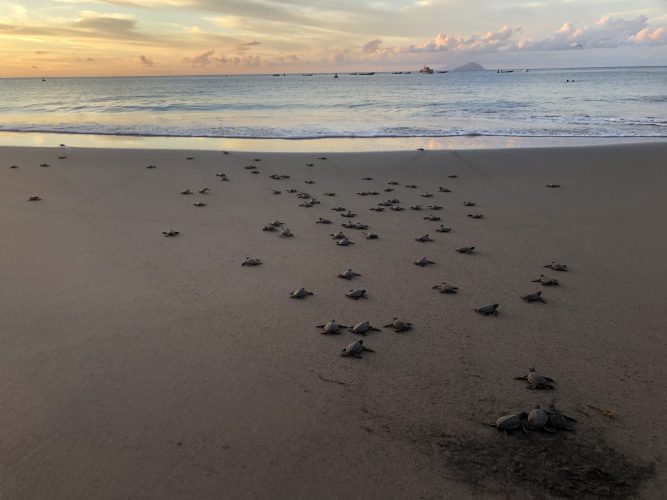Montserrat is not just famous for its volcanic mountains but also as a sanctuary for several species of sea turtles. Between June and October, the island becomes a haven for these majestic creatures as they come ashore to nest.
According to the Department of Environment, four species of sea turtle have been recorded to have nested on Montserrat. The Green Turtle and the Hawksbill are the most popular with the Leatherback being rare and the Loggerhead being very rare.
For nature lovers and eco-tourists, witnessing this natural spectacle is a profound experience. However, it’s crucial to approach turtle watching with respect and mindfulness. Here’s our comprehensive guide to enjoying turtle watching in Montserrat, ensuring the safety and preservation of these magnificent marine animals.
When to Go
The prime turtle nesting season in Montserrat runs from June to the end of October. During this period, you’re most likely to witness turtles like the Hawksbill and Green turtles making their way to the beaches at night to lay their eggs. Late nights and the early hours of the morning are the peak times to observe these creatures as they embark on their nesting ritual. If you are on a boat tour, be on the lookout for these gentle creatures swimming by.
Where to Go
Montserrat boasts several beaches known for turtle nesting activities. Rendezvous Beach, Lime Kiln Bay, and Old Road Bay are among the top spots where turtles are commonly seen. These areas are monitored for turtle activity, and guided tours are often available to help visitors experience turtle watching responsibly.
Best Practices for Turtle Watching
1. Keep a Respectful Distance
Always maintain a safe and respectful distance from the turtles. Disturbing them can cause stress, leading to unsuccessful nesting attempts. As a general rule, stay behind the turtle at all times to avoid being seen.
2. Minimize Light and Noise Pollution
Turtles are highly sensitive to light and noise, which can disorient them and their hatchlings. Use red light filters if you must use a flashlight and keep your voice low. Better yet, rely on the natural moonlight and the expertise of your guide to enjoy the experience.
3. Follow the Lead of Guides
Local guides are trained to interact with turtles in the least disruptive manner. Their instructions are designed to protect both the turtles and the visitors. Always follow their lead and instructions during tours.
4. No Flash Photography or Bright Lights
Flash photography can disorient and scare turtles. If you wish to capture the moment, do so without the use of flash. Many guides permit photography under specific conditions, so it’s essential to adhere to their guidelines. Use only red or amber lights to observe the turtles.
5. Do Not Handle the Turtles
Handling or touching the turtles or their eggs is strictly prohibited. These actions can cause unnecessary stress to the animals and potentially harm them or their offspring.
6. Support Conservation Efforts
Consider supporting local conservation efforts by donating or volunteering. Your contribution can make a significant difference in the preservation of turtle nesting sites and the overall health of Montserrat’s marine life.
7. Leave No Trace
Ensure you leave the beaches as you found them. Avoid leaving any litter behind and tread lightly on the nesting grounds to prevent disturbing the nests.
Why It Matters
By adhering to these best practices, not only do you get to witness one of nature’s most beautiful events, but you also contribute to the conservation of these endangered species. Turtle watching in Montserrat offers a unique opportunity to connect with nature, understand the importance of marine conservation, and create unforgettable memories.
Embarking on a turtle watching adventure in Montserrat is more than just an activity; it’s a pledge to respect and preserve the natural world. Let’s enjoy the beauty of nature responsibly, ensuring that future generations can also marvel at the sight of turtles nesting under the Caribbean moonlight.
Discover more from Discover Montserrat
Subscribe to get the latest posts sent to your email.





